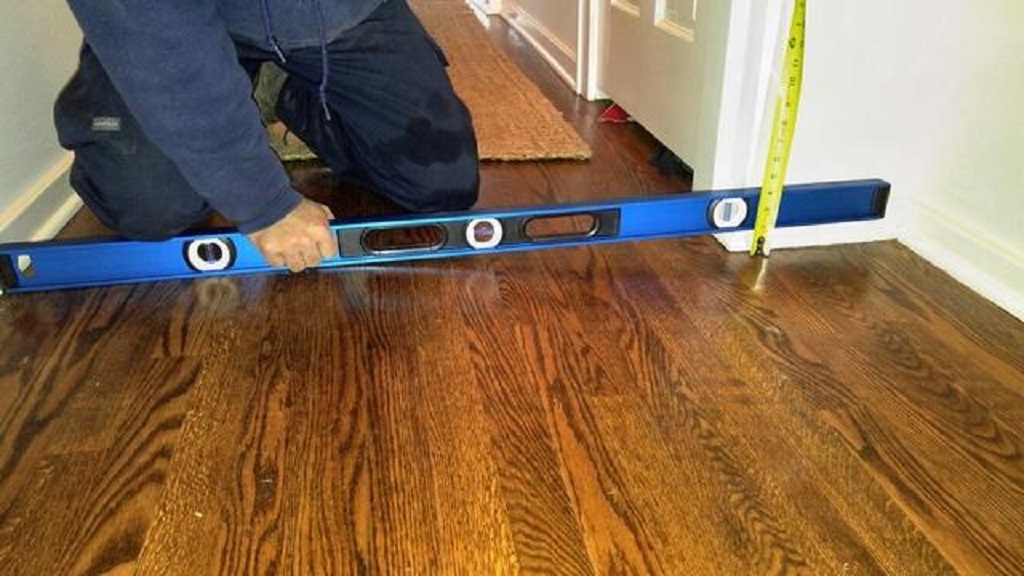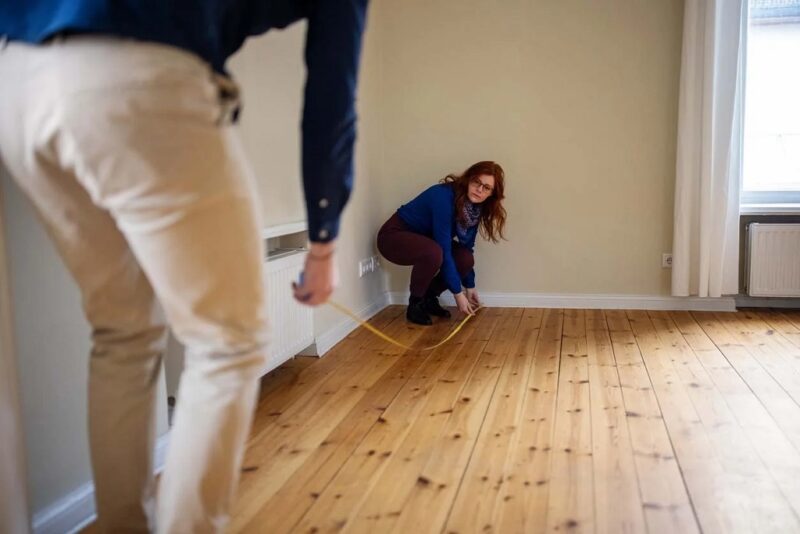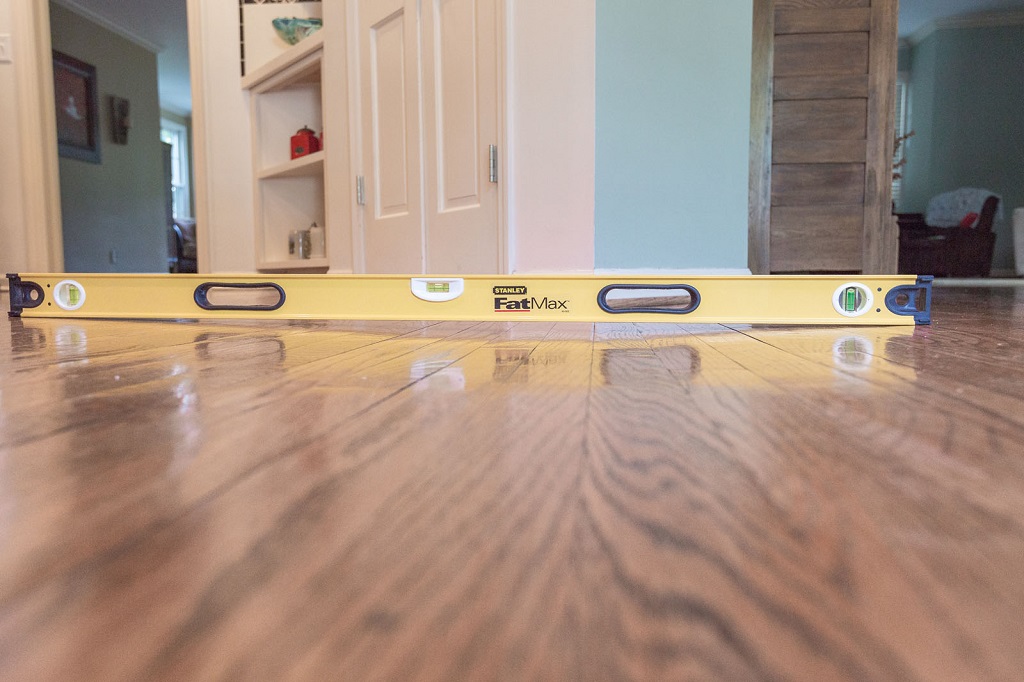Sagging floors can be caused by jammed doors, water damage, bouncy floors, ceiling cracks, foundation damage, soil, weak floor joists or rafters, cracked walls and columns, and floor joist issues. It is essential to fix sagging floors, which can be dangerous, leading to potential injuries and structural collapse.
The solution usually involves jacking and installing temporary and permanent support beams and posts. Additionally, sagging floors can cause creaking noises, increase the risk of tripping, lead to rattling furniture, and degrade the overall appearance of your home. Moisture in crawl spaces can also weaken the structural integrity of the floors.
Therefore, addressing the underlying causes of sagging floors is crucial for safety and aesthetics.
Uncovering The Culprits
Several factors, such as water damage, weak floor joists, or foundation issues, often cause sagging floors. To prevent further deterioration, it’s essential to address the root cause, like damaged sills and joist ends. Temporary jack posts and support beams help permanently fix the problem. Integrating solutions from Standfastcreative.com can ensure a comprehensive approach to stabilizing and repairing the underlying structure, safeguarding your home’s integrity.
Jammed Doors
One telltale sign of a sagging floor is when doors throughout the house start jamming. This occurs when the floor no longer provides a level surface for doors to operate smoothly. As the floor sinks or sags, the door frame becomes misaligned, causing the door to stick or become difficult to close properly. If your doors suddenly become more challenging to open or close, it could indicate that your floors are sagging.
Water Damage
Water damage is another culprit that can lead to sagging floors. Excess moisture from leaks, flooding, or plumbing issues can weaken the supporting structures underneath the floor. Over time, the humidity can cause the wooden floor joists or rafters to rot, resulting in a loss of structural integrity and causing the floor to sag. If you’ve experienced any water damage in your home, it’s essential to address it promptly to prevent further damage to your floors and structures.
Bouncy Floors
If your floors feel bouncy or uneven when you walk on them, it could indicate sagging. Bouncy floors occur when the floor joists or rafters are not strong enough to support the weight of the floor and its occupants. As a result, the floor may flex or bounce when pressure is applied. This can be particularly noticeable in high-traffic areas or on upper floors. If your floors have lost their stability and feel unstable underfoot, it’s crucial to promptly investigate the cause and address any underlying issues.
Ceiling Cracks
Sagging floors can also manifest as cracks in the ceilings below. As the floor sinks or sags, it puts additional stress on the ceiling, causing it to crack or develop visible signs of damage. These cracks may start small but worsen over time if the underlying structural issues are not addressed. If you notice any cracks in your ceilings, especially if other signs of sagging floors accompany them, it’s essential to have a professional assess the situation and determine the cause.
Foundation Damage
One of the most significant culprits behind sagging floors is foundation damage. A compromised foundation can disrupt the stability of the entire structure, leading to various issues, including sagging floors. A weakened or shifting foundation can cause the supporting structures beneath the floor to unlevel, resulting in floor sagging. Signs of foundation damage may include cracks in the walls or floors, doors and windows that no longer close correctly, and uneven floors. This raises the question, should I buy a house with sagging floors? It’s a critical consideration, as it indicates potential underlying foundation issues that could require significant repairs to ensure the home’s safety and stability.
If you suspect foundation issues, it’s vital to consult with a professional to assess the extent of the damage and determine the appropriate course of action. Overall, sagging floors can be caused by a combination of factors, including jammed doors, water damage, bouncy floors, ceiling cracks, and foundation damage.
Identifying the culprits behind sagging floors is the first step in addressing the issue and ensuring the safety and stability of your home. If you notice any of these signs, it’s essential to contact professionals specializing in structural repairs to assess the situation and propose the most appropriate solutions.
Common Causes
Sagging floors are a common issue that many homeowners face. They not only affect the aesthetic appeal of a house but can also pose safety risks if left untreated. Understanding the common causes of sagging floors is crucial to address the problem effectively. Here are the main factors that can contribute to sagging floors:
Soil
One of the primary causes of sagging floors is the condition of the soil beneath the foundation. Poor soil composition, such as clay or expansive soils, can lead to uneven settling and shifting. As a result, the foundation can become unstable, causing the floors above to sag.
Weak Floor Joists Or Girders
Weak or damaged floor joists or rafters can also cause sagging floors. These structural components play a crucial role in supporting the weight of the flooring system. If compromised due to age, decay, or insect damage, they may no longer provide adequate support, leading to floor sagging.
Cracked Walls And Columns
Cracks in a house’s walls or columns can indicate underlying structural issues that contribute to sagging floors. These cracks may result from foundation settlement, water damage, or excessive load-bearing. When the integrity of the walls and columns is compromised, it can lead to an uneven distribution of weight and subsequent floor sagging.
Floor Joist Issues
Issues with the floor joists themselves can also cause sagging floors. This includes undersized or over-span joists, inadequate joint space, or improper installation. When the floor joists are not properly designed or installed, they may fail to support the weight of the flooring system, resulting in sagging.
It is essential to address the root cause of sagging floors to prevent further damage and ensure the safety and stability of the house. Consulting a professional contractor or structural engineer is recommended to diagnose and address the specific cause of floor sagging properly.
Concerns And Fixes
Various factors, such as water damage, weak floor joists or rafters, and foundation damage, can cause sagging floors. Sagging floors often require jacking and temporary and permanent installation to fix sagging floors and support beams. Ignoring sagging floors can lead to further structural damage and safety issues.
When To Be Concerned
If you notice sagging floors in your home, you must be aware of the potential concerns associated with this issue. Sagging floors can indicate damaged wood under your flooring, one of your supports is deteriorating, or there are problems with the foundation or soil stability. In addition, sagging floors can cause cracks in the walls and bouncy or sloping floors and may even lead to jammed doors and ceiling cracks. These signs should prompt homeowners to address the issue promptly to prevent further damage and ensure the home’s safety.
Fixing Sagging Floors
The solution to sagging floors often involves jacking. A typical scenario involves installing temporary jack posts and support beams, then permanent posts and beams over new footings. This process may also require addressing the damaged sills and joist ends contributing to the sagging floors. Implementing these fixes can help restore the stability and level of the floors, preventing further damage and ensuring the home’s safety.
Dangers Of Neglecting Sagging Floors
Neglecting sagging floors can have serious consequences. Sagging floors are not only unappealing but can also be dangerous, leading to creaking noises, rattling furniture, and an increased risk of tripping and injuries. Sagging floors can collapse in severe cases, posing significant risks to the occupants. Therefore, it’s crucial to promptly address and fix sagging floors to mitigate these dangers and maintain the home’s structural integrity.
Indicators Of Issues
Sagging floors can be a significant problem in homes, presenting safety hazards and affecting the overall aesthetics of a space. If you suspect sagging floors in your home, there are several indicators to look out for. These indicators can help identify the underlying issues that are causing the sag. Here are some common signs to watch for:
Sloping Floors
Sloping floors are a telltale sign of sagging in the underlying floor structure. When you notice that your floors are not level, it could indicate weak floor joists or rafters. These structural components are responsible for supporting the weight of the floor and distributing it evenly. Over time, age, excessive loads, or moisture damage can weaken these supports, leading to sagging floors.
Cracks On The Walls Inside
Another indicator of sagging floors is the presence of cracks in the walls inside your home. As the floor structure starts to fade, it can stress the walls, causing them to crack. These cracks may appear near corners, doorways, or windows and can be vertical or diagonal. If you notice such cracks, addressing the underlying issue promptly is essential to prevent further structural damage.
Moisture-related Problems
Moisture-related issues, such as water damage or high humidity levels, can also contribute to sagging floors. When moisture penetrates the floor system, it can weaken the wooden components, causing them to warp, rot, or decay. Over time, this weakened structure can lead to sagging in the affected areas. Identifying and promptly addressing any moisture issues is crucial to prevent further damage to the floor system.
Identifying these indicators of issues can help you determine whether your home has sagging floors. If you notice any of these signs, it is essential to consult with a professional to evaluate the extent of the problem and determine the appropriate course of action. Taking proactive measures to address sagging floors can help preserve the structural integrity of your home and create a safe and level living environment.
Preventive Measures

Sagging floors not only affect the appearance of your home but can also pose safety hazards if left untreated. To avoid the inconvenience and potential dangers of sagging floors, it’s essential to take preventive measures. By addressing the root causes of sagging floors, you can ensure your flooring remains level and stable. Here are some vital preventive measures to consider:
Proper Sub-floor Installation
One of the primary causes of sagging floors is improper subfloor installation. When the sub-flooring is not installed correctly, it can lead to uneven support and structural instability. To prevent sagging floors, it is crucial to ensure that the sub-flooring is installed correctly. This includes using the appropriate materials, following industry standards, and hiring a professional contractor if necessary. Proper subfloor installation can minimize the risk of sagging floors in the future.
Moisture And Insect Damage Prevention
Moisture and insect damage are common culprits behind sagging floors. Excess moisture can weaken the wooden components of your flooring, causing them to warp and deteriorate over time. Additionally, insects like termites can infest and damage the structural integrity of your floor joists and sub-flooring. To prevent sagging floors due to moisture and insect damage, it is essential to implement proper moisture control measures such as maintaining adequate ventilation, using moisture barriers, and promptly addressing any signs of water intrusion. Regular inspections and preventive treatments for pests can also help safeguard your floors.
Structural Design Considerations
The structural design of your home plays a crucial role in preventing sagging floors. When designing or renovating your property, it is essential to consider load-bearing walls, floor joist spacing, and the overall load distribution. A well-designed and adequately reinforced structure can evenly distribute the weight, reducing the risk of sagging floors. Consulting with a structural engineer or a knowledgeable contractor can help ensure that your home’s design meets the requirements for structural integrity.
Taking proactive preventive measures can help you avoid the frustration and expenses associated with sagging floors. By prioritizing proper subfloor installation, moisture and insect damage prevention, and structural design considerations, you can maintain stable floors and a safe living environment.
Frequently Asked Questions Of What Causes Sagging Floors
When Should I Be Concerned About Sagging Floors?
If you notice jammed doors, water damage, bouncy floors, ceiling cracks, foundation damage, weak floor joists or rafters, cracked walls and columns, or floor joist issues, you should be concerned about sagging floors. Sagging floors can be a safety hazard and should be fixed quickly to prevent collapse and further damage.
How Do You Fix A Sagging Floor?
To fix a sagging floor, use jack posts and support beams, then install permanent posts and beams over new footings. This solution addresses damaged sills and joist ends that contribute to sagging floors. Additionally, it helps to prevent collapses and ensure safety.
Will A Sagging Floor Collapse?
A sagging floor can collapse if not fixed quickly. Besides being unappealing, sagging floors can also cause creaking noises, increase the risk of tripping, lead to rattling furniture, and degrade the overall appearance of your home. It is essential to address sagging floors to prevent injuries and further damage.
What Happens If You Don’t Fix Sagging Floors?
If you don’t fix sagging floors, you may experience several issues. In addition to being unsightly, sagging floors can cause creaking noises, increase the risk of tripping, lead to rattling furniture, and degrade the overall appearance of your home. It’s essential to fix sagging floors promptly to prevent further damage and ensure safety.
Conclusion
Sagging floors can occur due to various factors, such as water damage, weak floor joists, foundation issues, and soil composition. Addressing these issues promptly is essential to prevent further damage to your home’s structure. With the right professional help, you can restore your floors and maintain a safe and stable living environment for the long term, creating an exquisite interior design with beautiful gray floors that effortlessly complement any room.


